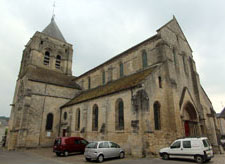Bruyères-et-Montbérault (Aisne, France) - La Visitation
- Disclaimer
The dating found here is based on the work of John James, and is meant on this site to serve as a starting point. James' dating is derived from a system that uses his interpretation of the development of capitals over time as the basis for chronology, among other factors. His goal is to refine the dating to within years rather than decades. I have not fully embraced James' methodology, and will be developing this page from its current state to one which is admittedly more conservative. The relative expenditure values found in the Timeline are also based on James' work, and I believe these to be reasonably reliable. They are intended only to give a sense of the amount of work involved in each decade.
I have added the idea of the "project" as a way of separating work in buildings. In my mind, a "project" is a discrete section of work in a building that resulted from the one-time acquisition of funding. "Projects" are generally separated by at least a decade where no work was being done. It is my view that it would have been unwise to start a "project" that could not be finished and protected from the elements, and as such a "project" usually involved a wing or multiple wings of a building, from floor to roof. Rural churches, which could only secure small amounts of funding at irregular intervals, often were the result of many small projects, while the great churches, which benefitted from relatively consistent funding, may have involved only a few large projects.
I have added the idea of the "project" as a way of separating work in buildings. In my mind, a "project" is a discrete section of work in a building that resulted from the one-time acquisition of funding. "Projects" are generally separated by at least a decade where no work was being done. It is my view that it would have been unwise to start a "project" that could not be finished and protected from the elements, and as such a "project" usually involved a wing or multiple wings of a building, from floor to roof. Rural churches, which could only secure small amounts of funding at irregular intervals, often were the result of many small projects, while the great churches, which benefitted from relatively consistent funding, may have involved only a few large projects.
- Timeline with Relative Expenditure (if available, in building units)
 |
 |
 |
 |
 |
 |
 |
- Project A - 1090s - Phase 1 - choir (b)
Choir in many campaigns; too hard to disentangle without an accurate survey; among the anomalies: varied arrangements of external drums and shafts, windows not central between external shafts, and on the interior oriented away from the main axes, curves outside walls look flattened as if made from arcs with separate centres, diameters of drums get smaller above the sills, wall set back from plane of drums in south corner, heads of windows straight, and curved only between them;
- Project A - 1100s - Phase 2 - choir walls
Choir lower walls
- Project B - 1120s - Phase 3 - choir (a)
Choir exterior sculpture with pause above the larger ones over the half drums where small capitals alongside come from a later campaign; chapel es2 later than taller ones in the east;
- Project B - 1120s - Phase 4 - north
North arm; es1w (c-) has 4 capitals that would be earlier than es1n clerestory, with later capitals set around them; therefore northern set of shafts were added; shows that the transept chapel was earlier (but has a drum and joined to centre); rib caps at 45 and are not built in while the way that e1 is set into the wall shows the ribs are later
- Project B - 1130s - Phase 5 - north raised
Earlier capitals raised and thin additional capitals set around them
- Project B - 1130s - Phase 6 - choir (a+)
Upper walls of choir with small exterior capitals set alongside larger ones over drums; cornice
- Project B - 1130s - Phase 7 - east (c+)
Raised the east 8 courses and moved caps up with them; es1w (c-) group of 5 capitals would be earlier than es1nclerestory, so northern set of shafts were added; therefore transept chapel earlier (but has a drum and joined to centre); rib caps at 45 (ribs
- Project B - 1140s - Phase 8 - nave
Big arches over double bays from nave only on north side; nave clerestory; used to have a wooden ceiling in the nave;
- Project C - 1160s - Phase 9 - tower
Tower
- Project C - 1170s - Phase 10 - south (d)
South transept dado seems to have been spolia from a cloister erected at a much later date.
- Project D - Later - Phase 11 -
Much later work in the transepts with windows and vaults
